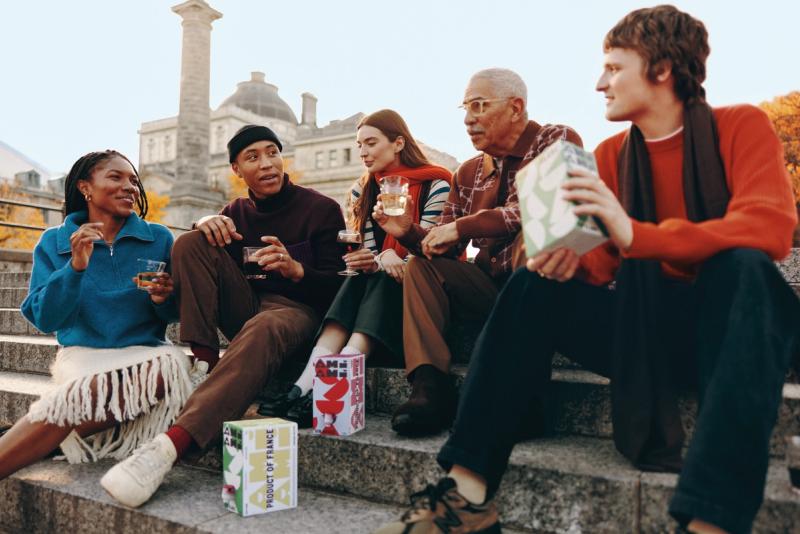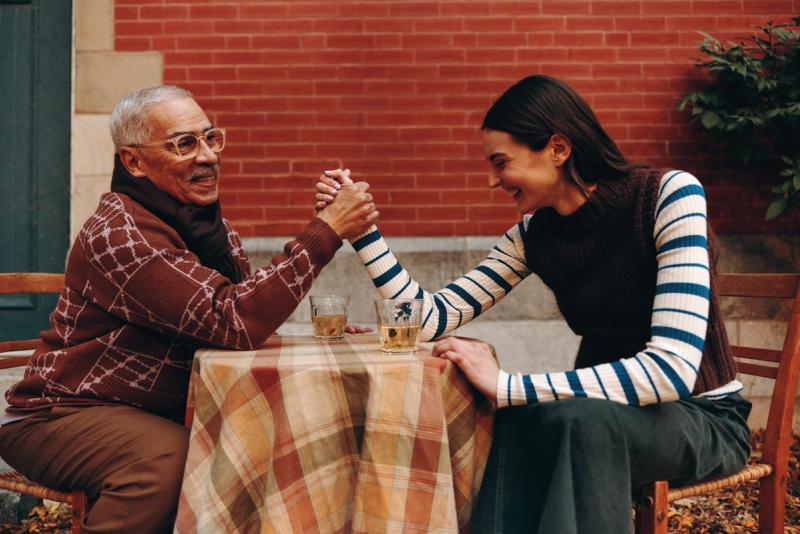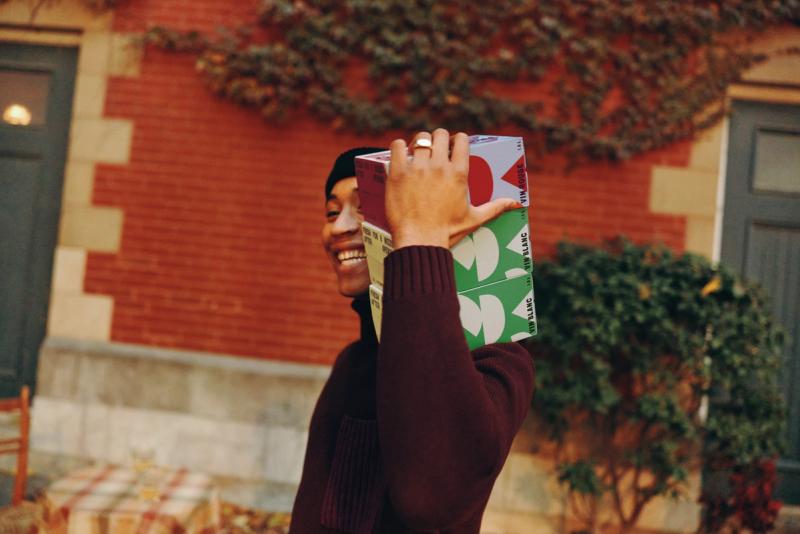The glass bottle is out and boxed wine is in, according to Ami Ami co-founder Woody Hambrecht, who’s building a sustainable wine business that’s aimed at a new demographic of drinkers.
Woody Hambrecht was nine years old when he had an epiphany. What started as a typical Sunday, having dinner with his family, turned into one of his most enduring memories, thanks to his 19-year-old uncle. “He’s like, ‘yo man, let’s go outside – I gotta play something for you’,” remembers Hambrecht. “We listened to the Beastie Boys’ Check Your Head in the car while the family was eating Chinese food. And I still remember that.
“My uncles introduced me to college radio and independent music radio shows, and I just fell in love with subculture,” he continues. “That’s carried me throughout my life, and those early cultural connections have infiltrated the way I think about brands, and my interest in brands and creation. I can’t do the same thing that everyone else is doing. And it stems back to being introduced to independent music as a young kid.”


The AUFI connection: AMI AMI asked us for an agency that could help them convince a new generation to buy boxed wine.


“My uncles introduced me to college radio and independent music radio shows, and I just fell in love with subculture,” he continues. “That’s carried me throughout my life, and those early cultural connections have infiltrated the way I think about brands.”
Woody Hambrecht – Co-Founder, AMI AMI
Hambrecht’s family has been involved in the wine business since the 1970s, starting with his grandparents. And now, together with co-founder Ross Dawkins, he’s combining that love of counterculture and all things contrarian in Ami Ami: a new boxed wine business that’s taking on one of the sector’s biggest sustainability problems by removing the glass bottle.
It’s hugely ambitious, considering boxed wine makes up only around 2.5% of the US market; but Ami Ami is set on wooing and converting the far larger 97.5% – and it’s doing so through a mainly direct-to-consumer model (although the business is now venturing into wholesale). Hambrecht and Dawkins’ approach is already seeing success, attracting buyers, appealing to restaurants who are keen to reduce wine wastage (Ami Ami stays fresh for six weeks after opening), and landing a GQ Cool New Stuff 2023 feature, which told readers: “Boxed wine is cool. No, we swear. It’s come a long way since the cheap stuff you drank in college.”


“Most people don’t know that two-thirds of the bottles in the US end up in landfill,” he tells AUFI. “They just think it’s recyclable. Most people don’t know how much energy it takes to produce that glass bottle.”
Woody Hambrecht – Co-Founder, AMI AMI
It’s true that drinkers have traditionally been a bit sniffy about boxed wine, which has historically been the less appealing option. Part of that is down to quality, and the rest is our hangup on the ritualistic element of uncorking and pouring from a bottle. Those glass bottles might not seem like an unsustainable material choice, but Hambrecht is here to tell a different story. “Most people don’t know that two-thirds of the bottles in the US end up in landfill,” he tells AUFI. “They just think it’s recyclable. Most people don’t know how much energy it takes to produce that glass bottle. Most people don’t realise that glass bottle is then thrown on a boat, goes over the ocean, goes on a truck or a train, gets filled, and goes back on a truck or train. And amidst all of that, it’s really heavy.
“So what you think is a really sustainable vessel, that’s infinitely recyclable, is actually not in most cases. That was something we wanted to solve. That takes a lot of education though, because no-one really knows that. I run an organic ranch and have for 10 years. I’ve been eating from farmers’ markets my whole life, and growing organic vegetables. I didn’t know this about glass until a couple of years ago. If I didn’t know it, and I’m someone who’s pretty tapped into this sustainable world, then how would your average Joe?”



According to Hambrecht, the wine industry’s facing other major challenges as well – particularly when it comes to selling to young people who are drinking less, and more likely to consume beer, cocktails, or hard seltzers, rather than pledging loyalty to wine alone. He says he knew Ami Ami had to adopt a radically different approach to connect with this demographic, and leverage design, events, and social media to break through.
Hambrecht and Dawkins worked closely with Montreal- and LA-based design studio Wedge – introduced to him by AUFI – on the strategy and visual identity of the brand, which he says is “about standing out, and people connecting with it, and seeing it and thinking, ‘oh, I’ve never seen anything like that before, and I want it in my fridge and on my countertop’.”
“The whole strategy for the business was to create this incredible box that would attract people to the brand, and make people curious to try it.”
Justin Lortie – Founder & Design Director, WEDGE
Justin Lortie, founder and design director at Wedge, says the studio knew from the beginning that Ami Ami boxed wine had to grab people by the eyeballs. “Usually, this category is a lower quality wine, and it feels like a label stuck on a box that’s a larger format version of a bottle. You’re not getting the real deal. Woody’s idea was around instead starting a company from the box.
“People are not going to buy a brown cardboard box with green type saying, ‘Sustainable Wine’,” he continues. “It’s never going to happen … [it was about] how we were going to convert people in this business, and we set the intention of creating the most desirable box – a MoMA Design Store-worthy box. The whole strategy for the business was to create this incredible box that would attract people to the brand, and make people curious to try it.
“This is where design convinces people to consider it or, in this case, taste it.”
Justin Lortie – Founder & Design Director, WEDGE
“This is where design has impact. This is where design convinces people to consider it or, in this case, taste it. It’s where design talks to the brand, and says, ‘look how this is so different and so special’. It helps a business communicate their values and who they are, and what they’re doing as a product. Because if no-one sees it, no-one tries it. Design is almost the only lever that you can use to step up your business and bring conversion, and awareness.”


Is there a risk in looking so conspicuously different to your competitors? Lortie says there’s a fine line that founders and agencies have to walk together to find “the most advanced yet acceptable solution”. According to him, successful brand strategy identifies the culture and rhythm of where people are at, and then responds to that. “If you go 200% and do a boxed wine that looks insane, and has fireworks, and resembles a rave poster from the 90s, people will be like, ‘yes, it’s very different.’ But what’s important, and part of the work we do, is taking that business idea, seeing where it fits in culture right now, and how far we can go to successfully launch to market. That’s where design should not be an arbitrary answer.”
Beyond the visual side of things, Hambrecht says he’s keen to break with tradition in terms of language – offering a counterpoint to the more “elitist lens” you might get from a traditional wine business. Products on the Ami Ami website are described in straightforward, relatable language. ‘Smells like’ and ‘Tastes like’ notes use icons to convey the flavour profile in a way that’s easy to understand, but still evocative.
“Design is almost the only lever that you can use to step up your business and bring conversion, and awareness.”
Justin Lortie – Founder & Design Director, WEDGE


“We want Ami Ami to be about inclusivity and friends and bringing people together, not about intimidating someone into trying to buy your product,” he concludes. “The legacy, old-school producers had a playbook that worked, and that was speaking in this language that no-one can really relate to, and where people are intimidated by the process of tasting wine.
“You don’t know how many tastings I've done in my career, and you can have the most confident person in the world, and you put a glass in front of them and they don’t know how to talk about it. What we’re trying to do with Ami Ami is say that doesn’t matter. Is this good? Is it a great way for you to connect with your friends? Or is it a convenient vessel if you live alone, and want one glass of wine, and don't want to open a bottle that’ll go bad in a couple of days? The essence of what we’re doing here is really trying to look at wine completely differently.”
ami-ami.vin
“We want Ami Ami to be about inclusivity and friends and bringing people together, not about intimidating someone into trying to buy your product.”
Woody Hambrecht – Co-Founder, AMI AMI





